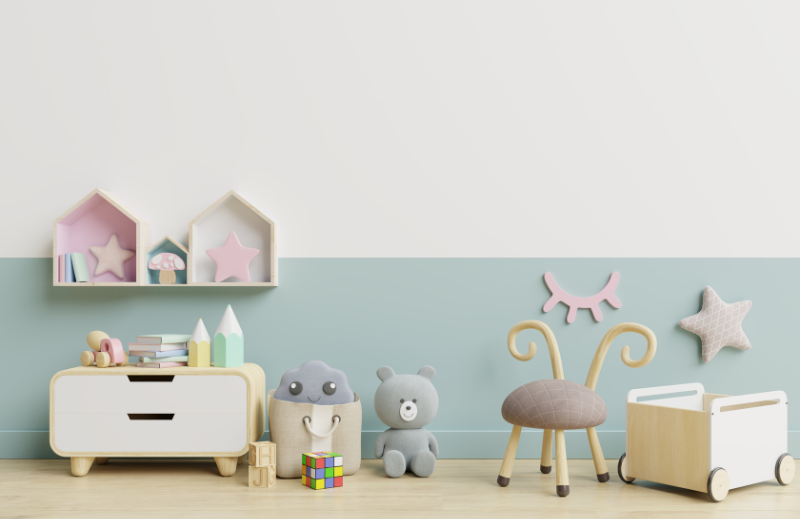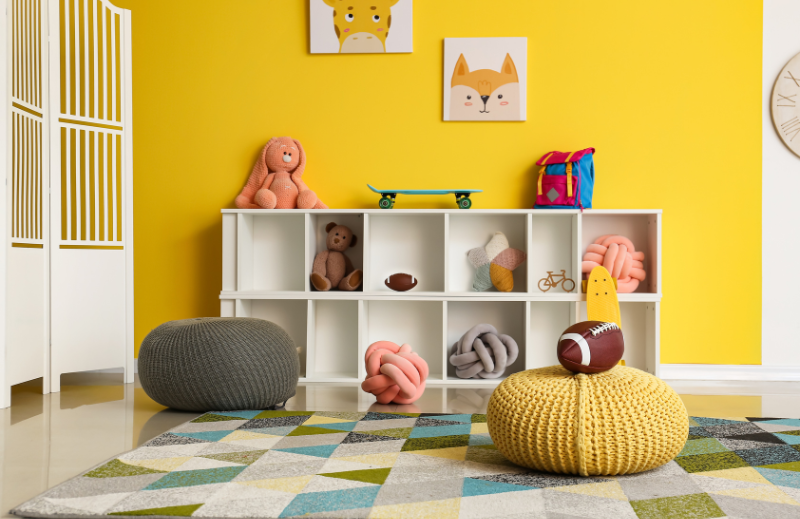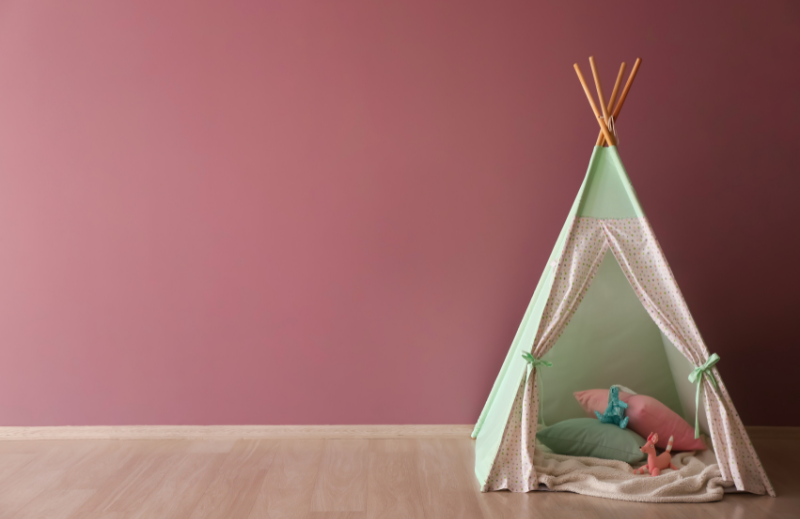No products in the cart.
Get Inspired, Other
The Impact of Color in Kids’ Room Wallpaper: A Psychological Perspective

The environment we create for our children serves as a foundational element in their growth and development. Every detail, from the furniture we select to the ambient lighting, plays a role in shaping their experiences and perceptions. One often overlooked aspect, yet deeply influential, is the choice of colours and designs that adorn their walls. Beyond merely adding a visual appeal, these choices echo in the daily lives of our young ones, influencing their thoughts, feelings, and behaviours.
Wallpaper for kids should be more than mere aesthetics and appearances. While a visually pleasing room is essential, the psychological effects of our design choices are even more profound. Wallpapers are instrumental in dictating the room’s aura, affecting moods, emotional well-being, and even cognitive functions. By delving into the intricacies of color psychology, we can arm ourselves with the knowledge to curate spaces that not only look beautiful but also foster holistic development for our children.
Why Color Matters in Kids’ Rooms
Children’s rooms serve as multifunctional spaces: playgrounds, study nooks, and sanctuaries where their personalities evolve. The chosen wallpaper sets the mood and can either invigorate or calm their spirits. Furthermore, specific shades and patterns can stimulate learning, creativity, and even help in relaxation, making the choice even more critical.
1. Blue: The Calming Hue
Blue, with its tranquil tones, has always been a favourite for promoting serenity and calmness. Selecting a blue wallpaper for kids can not only help in ensuring they sleep better but also provide a peaceful ambiance for relaxation. Studies have also shown that blue can aid in enhancing concentration and focus. Children surrounded by blue tend to feel more secure and comfortable, making it an excellent choice for young learners. Its universality also means it can easily transition as the child grows, proving to be a timeless choice.

2. Green: The Harmony of Nature
Green embodies the essence of nature, balance, and growth. When used in wallpaper for kids, it doesn’t just brighten up the space but also infuses feelings of harmony and rejuvenation. Green is known to reduce anxiety, making it beneficial for children who might need a calming environment. As an added bonus, green also aids cognitive development, encouraging creative thought processes. Introducing green to urban kids can foster a connection with nature, reminding them of the outdoors and its therapeutic benefits.

3. Yellow: The Ray of Sunshine
Bright and buoyant, yellow is the colour of optimism and energy. Incorporating this shade in wallpaper for kids can make the room come alive, fostering enthusiasm and a zest for life. While it’s invigorating, it’s essential to strike a balance. Too much yellow might be overwhelming, leading to restlessness. However, when used in moderation, especially with complementary colours, it can uplift spirits, enhance mood, and improve attention span. It’s the touch of sunshine every room can benefit from.

4. Pink: Soft and Soothing
Pink is more than just a pretty colour. It has calming properties that can reduce feelings of aggression and hostility. Especially in softer shades, pink can induce feelings of warmth, love, and nurture. While traditionally associated with girls’ rooms, contemporary designs have embraced pink in innovative, gender-neutral ways. When choosing pink wallpaper for kids, consider incorporating patterns or textures. This not only adds depth to the design but also ensures that the room remains versatile and adaptive to the child’s evolving tastes.

5. Red: The Dynamic Colour
Red, the colour of passion and dynamism, can invigorate and inspire. While it’s a bold choice, when incorporated thoughtfully in wallpaper for kids, it can act as a catalyst for excitement and creativity. Red stimulates the mind, increasing alertness and enthusiasm. However, like yellow, it’s essential to use red judiciously. Combining it with neutral tones or using it for accents can break monotony without overwhelming the senses.

Neutral Tones: A Canvas for Creativity
Neutral colours, often underrated, offer unmatched versatility. They present a blank canvas, allowing children the freedom to personalise their spaces with vibrant art, toys, and decor. Wallpapers in beige, grey, or soft white adapt seamlessly as kids mature, accommodating their changing preferences. They also blend effortlessly with various furniture and accessories, proving both functional and stylish.
Patterns and Themes: Beyond Just Colour
Designs and motifs in wallpapers add another dimension to room decor. From stars to animals or abstract patterns, they can stimulate imagination and curiosity. While selecting wallpaper for kids, ensure the design resonates with their age, interests, and personality. It’s also worth considering how easy it will be to update the room’s decor around the wallpaper as they grow, ensuring longevity in design choices.
The Role of Texture and Material in Kids’ Wallpaper
While colour undeniably plays a significant role in shaping a child’s environment, the texture and material of wallpapers are equally pivotal in adding layers of sensory experiences. Children are inherently tactile learners, drawn to touch and feel their surroundings.

1. Textured Wallpapers
Embossed or textured wallpapers can provide a sensory-rich environment for children. Patterns with raised designs can stimulate a child’s tactile senses, encouraging them to interact with their environment. For instance:
Velvet Textures: Soft and plush, velvet-textured wallpapers can evoke feelings of warmth and cosiness. It’s especially suitable for younger children, creating an enveloping, womb-like environment.
Grainy or Sand Textures: These can give an earthy, natural feel to the room. It reminds one of nature, beaches, and outdoor adventures, subtly fostering an affinity for the environment.
2. Material Matters
The material of the wallpaper can determine its durability, safety, and impact on indoor air quality. Here’s a brief overview:
Vinyl Wallpapers: These are durable, easy to clean, and resistant to moisture. However, ensure that they don’t contain harmful chemicals or phthalates, especially in a child’s room.
Non-woven Wallpapers: Made from natural plant fibres, these wallpapers are environmentally friendly and breathable, ensuring a healthier indoor environment.
Fabric Wallpapers: These can add a touch of luxury and softness to the room but might require more care in terms of maintenance.
3. Reflecting Personalities through Wallpapers
Every child is unique, and their room should mirror their personality, interests, and dreams. Wallpapers offer a medium to do just that:
For the Astronaut: Wallpapers showcasing galaxies, stars, and planets can transport a child to outer space, nurturing their curiosity about the universe.
For the Nature Lover: Lush green forests, playful animals, or underwater scenes can bring the wonders of nature right into their room.
For the Artist: Abstract patterns, splashes of colours, or even wallpapers that can be drawn or painted on can act as a canvas for their creativity.

To Wrap it Up
When it comes to designing spaces for our children, the choices we make carry weight and significance far beyond mere decoration. The walls they grow up around, the colours they see daily, and the patterns they interact with, all contribute silently to their holistic development. The process of selecting wallpaper for kids is a delicate dance, harmonising the principles of design with the nuances of child psychology.
In this endeavour, aesthetics and psychology are interwoven intricately. While the immediate goal might be to achieve a visually appealing space, the long-term vision should be to cultivate an environment conducive to emotional balance and cognitive stimulation. The challenge lies in striking this balance. But when achieved, the result is a space that’s not only breathtaking in its beauty but also instrumental in nurturing the young minds that inhabit it.
Note: Always prioritise wallpapers that are of top-tier quality, eco-conscious, and child-friendly from the best wallpaper vendors.
Frequently Asked Questions (FAQs)
1. How often should I consider changing the wallpaper in my child’s room?
Answer: Typically, high-quality wallpapers can last for many years. However, considering a child’s evolving tastes and interests, you might want to update the wallpaper every 5-7 years or as you notice a significant change in their preferences.
2. Are there wallpapers that can be easily updated or changed?
Answer: Yes! There are removable or “peel-and-stick” wallpapers available in the market. They can be easily applied and removed without damaging the walls, making them perfect for frequently updated kids’ rooms.
3. What’s the best way to clean and maintain wallpapers in a child’s room?
Answer: Vinyl wallpapers are the easiest to clean; a damp cloth usually does the trick. For other types, it’s advisable to dust regularly and gently wipe with a slightly damp cloth. Always refer to the manufacturer’s guidelines for specific cleaning instructions.
4. How can I ensure the wallpaper material is safe for my child?
Answer: Look for wallpapers that are free from harmful chemicals and VOCs. Non-woven and fabric wallpapers are generally eco-friendly options. Always purchase from reputable brands and check for safety certifications.
5. Can I involve my child in choosing the wallpaper?
Answer: Absolutely! Involving your child in the selection process ensures the room reflects their personality. It can also be a fun activity to do together, leading to a space they genuinely love and connect with.
6. Are there wallpapers that can serve educational purposes?
Answer: Yes, there are educational-themed wallpapers that feature alphabets, numbers, maps, or even interactive elements. With the advent of technology, augmented reality wallpapers can also provide interactive learning experiences.
7. What if my child wants to change the theme frequently? Are there cost-effective solutions?
Answer: Consider using removable wallpapers or wall decals. These allow for more frequent changes without significant expenses. Alternatively, opt for neutral wallpapers and accessories with themed decor items, which can be more easily swapped out.
Remember, the ultimate goal is to create a space where your child feels comfortable, inspired, and truly at home. Whether through wallpaper or other design elements, prioritise their well-being and happiness.
Deepak | Guest Writer
Passionate writer and Interior design enthusiast

